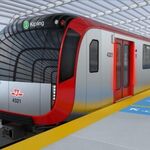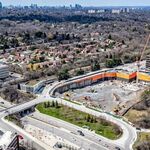Easy to counter a point that's never been made by anyone and never will be, eh?
You made it sound like it's an argument/excuse
not to save the Hawkers ("transit history doesn't revolve around them, so they shouldn't be saved"), to which I pointed out that it's not seen as such for the SRT.
You say like this like the TTC has an ample historical fleet and they just left out the Hawkers out of spite. I would advise you to read through the CPTDB wiki rosters carefully, and you will find that most of what has ever run in this city was scrapped without a second thought.
As far as subway cars go, yes the Hawkers have thus far been the only subway cars to retire and not be saved (both their predecessors, the G1s & M1s, have been saved, while both of their successors, the T1s & TRs, won't retire for nearly a decade at best (T1s), or several decades at worst).
And when time comes to replace the current subway fleet (T1s, then TRs) and then they magically find a way to save either of those (or both), then yes they would have an ample historical (subway) fleet of everything except the Hawkers, so there'd be no falsifying the statement that they left out the Hawkers out of spite (not that it would make the situation any better if it wasn't out of spite).
From personal experience, one visit to New York that includes accomodation that wouldn't give me bed bugs cost somewhere in the neighbourhood of $3500
I don't know what fancy luxury accommodations you've had, but in my case a trip to New York for 2–3 days would typically total somewhere around $500 (usually accommodations were decent, but last time not so much). Hell, even my last trip to Europe for a week totaled roughly $2000.
And anyway, "why save something when it exists half a continent away in a city that you can afford to visit a few times in your lifetime?" is not a convincing argument, not anymore then "My favourite subway car was not saved, so we should never save anything ever again, to make it fair."
Just because you disagree doesn't mean both of those are not valid, reasonable arguments. Anyway, by that logic, Bratislava shouldn't have saved second-hand streetcars from Prague to make up for what they failed to save of their own fleet, since those particular cars weren't part of
their transit history.
But since that's apparently good enough for you, there are HawkerBombardier cars still in operation in Ankara. Happy hunting!
I'm aware, and would love to
possibly visit
someday, except they don't have any historical fleet that I know of, so I have little doubt that those will disappear in the coming years too.
Edit: idk how accurate this is, but according to wiki they were only in service 1997–2019, meaning only 22 years and long gone by now??! I sure hope that's not true.
well you can add almost everything from the TTC's predecessor companies, for a start.
And the TTC's predecessor companies ceased to exist like what, 100 years ago, when the TTC was created? I also specifically meant the last few decades, i.e. the latter half of the 20th century, around the time the Hawkers came to be and onwards.
And, funnily enough, a Mark I car with a cab is something no other city ever had, so even by your own limited parameters for what makes something worthy of saving, a Mark I car most definitively falls under that.
Not that radical of a difference, anymore than a TR with a cab (5386) vs without (5384), as long as they're the same under the hood. A TR running in ATC mode might as well not have cabs either (they could probably remove cabs entirely if they wanted to, which they don't), but it's still the same thing as a TR running manually (see also: Budapest lines 2 & 4, which both have the same type of rolling stock, but line 4 running fully automated without cabs, and line 2 manually with cabs).
If our Mark Is had a propulsion system that was different than that of the other Mark Is (or at least a different version of it, much like the ALRV has a different version of chopper control propulsion than the CLRV), then I'd agree they'd be unique to Toronto.




